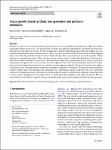Item Infomation
Full metadata record
| DC Field | Value | Language |
|---|---|---|
| dc.contributor.author | Hyun Jin, Kim | - |
| dc.contributor.author | Hans Christian, Rundfeldt | - |
| dc.contributor.author | Inpyo, Lee | - |
| dc.date.accessioned | 2023-05-25T03:44:54Z | - |
| dc.date.available | 2023-05-25T03:44:54Z | - |
| dc.date.issued | 2023 | - |
| dc.identifier.uri | https://link.springer.com/article/10.1007/s10237-023-01703-8 | - |
| dc.identifier.uri | https://dlib.phenikaa-uni.edu.vn/handle/PNK/8503 | - |
| dc.description | CC BY | vi |
| dc.description.abstract | Biological tissues receive oxygen and nutrients from blood vessels by developing an indispensable supply and demand relationship with the blood vessels. We implemented a synthetic tree generation algorithm by considering the interactions between the tissues and blood vessels. We first segment major arteries using medical image data and synthetic trees are generated originating from these segmented arteries. They grow into extensive networks of small vessels to fill the supplied tissues and satisfy the metabolic demand of them. Further, the algorithm is optimized to be executed in parallel without affecting the generated tree volumes. The generated vascular trees are used to simulate blood perfusion in the tissues by performing multiscale blood flow simulations. One-dimensional blood flow equations were used to solve for blood flow and pressure in the generated vascular trees and Darcy flow equations were solved for blood perfusion in the tissues using a porous model assumption. Both equations are coupled at terminal segments explicitly. | vi |
| dc.language.iso | en | vi |
| dc.publisher | Springer | vi |
| dc.subject | perfusion simulation | vi |
| dc.subject | Tissue-growth-based synthetic | vi |
| dc.title | Tissue-growth-based synthetic tree generation and perfusion simulation | vi |
| dc.type | Book | vi |
| Appears in Collections | ||
| OER - Kỹ thuật điện; Điện tử - Viễn thông | ||
Files in This Item:

